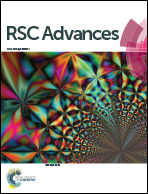Odd–even effect on the thermal properties of Schiff base functionalized dicyanate esters and thermo-mechanical properties of their blends with epoxy resins†
Abstract
An odd–even effect was observed in the case of dicyanate esters described in this work. The diamines were converted into their corresponding bisphenols by reacting with 2-hydroxybenzaldehyde and followed by treatment with cyanogen bromide which resulted in the dicyanate ester (CE). The synthesised dicyanate esters were confirmed by FT-IR and NMR spectral studies. The curing studies of the dicyanate esters were measured by using differential scanning calorimetry (DSC). The thermal properties depend on the length of the alkyl spacer. The maximum curing temperatures (Tmax) of these cyanate esters were in the range of 229–278 °C. The 5% weight loss temperature (T5%) was found to be in the range of 415 to 467 °C and the 10% weight loss temperature (T10%) ranged from 509 to 530 °C. The char yield of these polycyanurate networks is found to be in the range of 70.78 to 73.12 at 700 °C. Scanning electron microscopy (SEM) analysis reveals brittle behavior for the neat cured dicyanates while that of CE/epoxy blends show uniform dispersion of the cyanate ester. The storage modulus and glass transition temperature of cyanate/epoxy ester blends were found to decrease slightly with increasing cyanate ester content (1–10%). From the polarized optical microscope studies, all the uncured dicyanate esters show crystalline properties.


 Please wait while we load your content...
Please wait while we load your content...